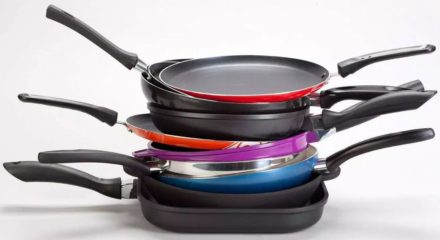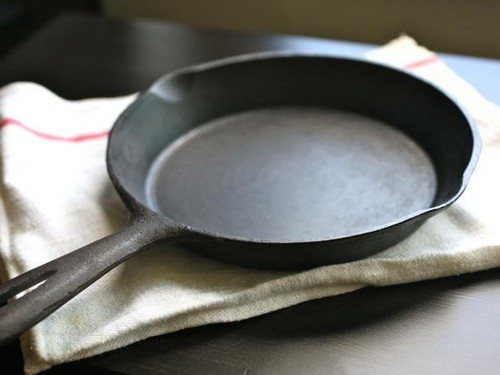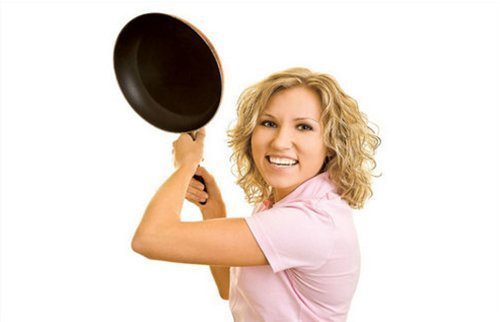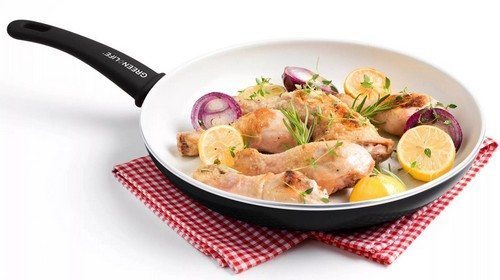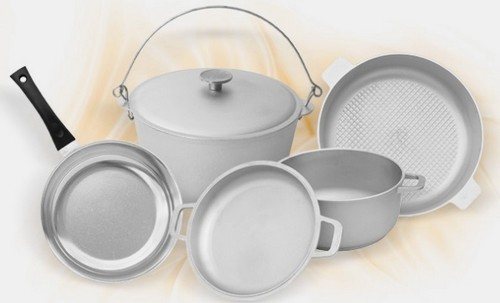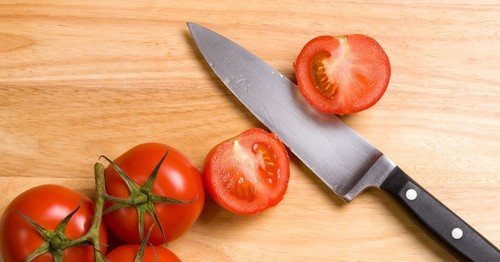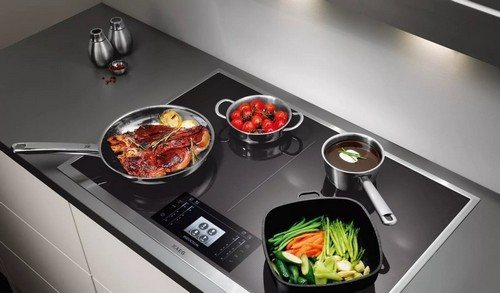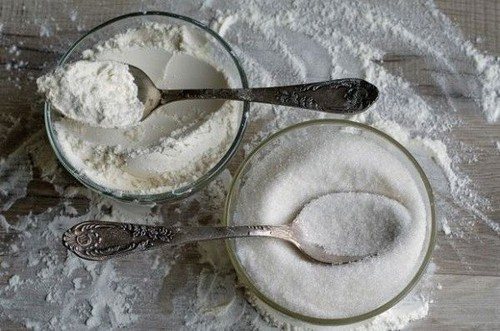The frying pan is one of the main tools for cooking. But it often happens that food burns to the frying pan during frying. How to avoid this and cook a delicious fried dish?

Reasons why food burns to the pan
As a rule, the frying pan burns for a reason. Certain conditions must be created. Often this happens due to:
- buying a low-quality frying pan. Companies that respect their reputation make cookware that lasts at least 2-3 years. A second-rate fake deteriorates in the first year of use;
- mechanical damage. This is due to the use of metal knives, spatulas, forks for mixing and sponges for cleaning, with storing pans one in another;
- expiration date. Consider the quality and material when calculating the service life;
- sudden temperature changes. Do not move the pan from a hot stove to the refrigerator and vice versa;
- use of abrasive cleaning agents that damage the structure of the surface to which they are applied;
- increased porosity of the metal (aluminum, cast iron and enamel).
What to do?
There is no universal remedy for removing burnt-on food from the surface of a frying pan. It is important, first of all, to consider what material it is made of. Only then, having studied all its features, you can begin cleaning.
Cast iron
It is durable. The following tips can help in the fight against burning:
- Initially, when buying, thoroughly wash it, dry it, pour salt 1 cm high, put it on a preheated stove, stirring the salt for an hour.
- If it has already been in use, remove the burnt marks, wash, dry and bake it on the stove. Next, you need to coat it with oil both from the outside and from the inside and place it in the oven, after turning it upside down and placing foil under it (provided that the handle is not made of wood). Set the temperature regulator to 180 degrees, let it stand in the oven for an hour, turn it off and, without removing it, wait until the utensil has cooled down. Take it out and try not to use it for a while (3 days - a week).
Aluminum
Similar care is required after purchase. If the dishes start to burn over time, you can revive them as follows:
- wash, heat over medium heat;
- cut the bread into cubes and distribute it over the entire inner surface;
- reduce the heat and fry it for 5 minutes.
Non-stick coating
It seems that it should be the most protected, but food also burns to it. The reason for this is the thinning of the protective layer. Unfortunately, it cannot be restored. The frying pan is sent to a well-deserved rest, especially if it has served for a very long time. If it becomes unusable quickly, the reason for this may be an initially very thin layer of non-stick protection or improper operation.
Try boiling water with grated laundry soap in it for 15 minutes. You should drain this liquid, wipe the bottom with a sponge, dry it, rub it with oil and try to fry the food. If it doesn’t help, then you’ll have to say goodbye 100% to the utensils.
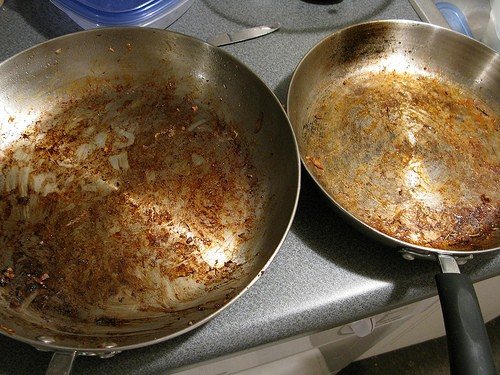
Enameled
It is prone to burning, as it has a porous structure and is one of the most problematic in terms of the fact that it cannot be heated.The only way to save utensils is by using cleaning products and lubricating its surface with a piece of lard or fat.
Ceramic
This is the most harmless option for the human body, but despite this advantage, it does not last long. Under ideal conditions it lasts from 2 to 4 years.
If it burns, you should:
- Wash thoroughly without using metal sponges or deforming cleaning agents;
- For stubborn stains, pour soapy water or sprinkle the stains with moistened baking soda and let stand for about 20 minutes. After time has passed, clean with a melamine sponge.
For preventive purposes, every month wipe the utensils with oil 1-2 times using a napkin and let them stand like that for a day.
Stainless steel
The material is distinguished by its reliability and durability, so any problems that arise are associated with violation of the rules of use. Stainless steel cookware lasts for decades, given that the ratio of chromium to nickel in steel is 18 to 10.
Help:
- clean and rinse (any items and types of cleaning products are acceptable) until shiny;
- remember the rules for further operation (heating should be strong until drops of water “dance” and the oil poured before frying should have time to heat up).
These recommendations will help prevent further episodes of burning.
Grill
Has a grooved bottom. It is made from the same materials as conventional ones, therefore, in order to choose the most suitable anti-stick option described above, you need to find out what metal it consists of.
If only the middle burns
The phenomenon in which burns form only in the middle is associated with heating devices. This problem most often occurs among those who use gas burners. The heat is distributed unevenly along the bottom, and the greatest heat occurs in the center of the pan. The heat from the flame does not dissipate and is directed directly. With large cookware, the food in the middle cooks much faster during the cooking process, which contributes to the formation of soot. You can solve the problem by purchasing a frying pan with a smaller diameter. It is also effective to use a special device that cuts through the fire and distributes heat over the entire bottom area.
How to avoid burning?
Before use, prepare the frying pan: wash it thoroughly and wipe it with oil or fat. Those utensils made of cast iron require calcination of 1 cm of poured salt for an hour.
Adviсe:
- Lubricate with plenty of oil, lard or fat before each use.
- After distributing it evenly, pour a little salt on the bottom and heat the frying pan.
- For those made of porous metals (cast iron, aluminum), pour apple cider vinegar and wait until it evaporates over low heat.
- After the described procedures, start cooking.
- Stirring food should not be done with spoons, iron spatulas, knives or anything that has a hard surface. This can leave scratches that compromise the protective layer and damage the pan. The most optimal are items made of wood or plastic.
- When washing, avoid hard sponges and brushes. Cleaning agents are not recommended.The best option is good old baking soda diluted with water.
- The dishes should be wiped dry. This will prevent mold and rust from forming, which can reduce the non-stick properties.
- Pans should be stored separately from each other, without stacking them. This ensures the safety of their surface.
Caring for frying pans
Tips for caring for a frying pan depending on the material from which it is made.
Teflon coated
It does not require special care. Thanks to Teflon, it independently prevents the formation of soot both inside and outside. If it does appear, then you need to fill the frying pan with hot water for half an hour. For greater effect, you can add a drop of detergent or add 3 tbsp. spoons of baking soda. The carbon deposits will dissolve without the use of prohibited abrasives. Wipe it with a soft sponge.
It is important to remember that the Teflon coating is easily damaged.
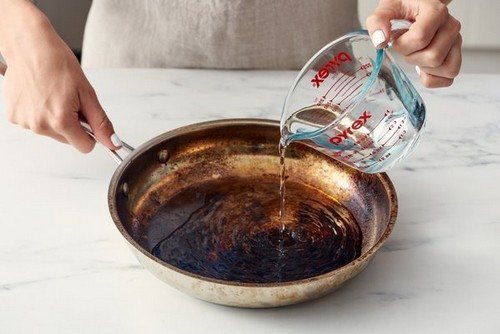
Stainless steel
Steel is the most finicky metal from which cookware is made. A minor defect is immediately visible, and food easily sticks to the surface.
You can clean carbon deposits from stainless steel using table salt, soda or vinegar with citric acid.
Cast iron
They are practically eternal, unpretentious and harmless. Cast iron frying pans can be called eternal. They are absolutely easy to care for and do not release harmful substances into food. In addition, they do not lose their appearance even over the years. All you have to do is clean off the carbon deposits in a timely manner. There are several recipes for the best ways to get rid of it.
For cast iron frying pans, care recipes intended for steel ones are suitable.You can also use both baking soda and citric acid vinegar. In addition, cast iron is not afraid of contact with abrasives, so you can safely clean them with brushes and metal sponges.
Ceramic
They are becoming more and more popular. Its surface is smooth and uniform. They are one of the easiest to care for. Any scratch can make the frying pan unusable, so you need to purchase special products for ceramics to dissolve carbon deposits.
Service life of pans
| Material from which the frying pan is made | Life time |
| Cast iron | Decades |
| Stainless steel | Up to 6-10 years |
| Ceramics | From 3 to 5 years |
| Aluminum | From 3 to 8-10 years |
| Non-stick coating | From 3 to 10 years (depending on texture) |
| Enameled | Becomes unusable after any damage |
Which pans are the least likely to cause food to burn?
Without a doubt, the leader in this rating is a frying pan with a special protective non-stick coating. But don’t be mistaken about the fact that you can cook with it without oil. It is necessary, only much less is required. A drop is enough. An additional advantage: you do not need to closely monitor the heating process.
At the end of the list are frying pans that have a porous surface. For example, cast iron. It requires a large amount of oil for coating and frying, so that it forms a layer that protects against the formation of burning.
The most difficult case is steel cookware. Metal is finicky: it heats up unevenly and quickly, requiring more oil and thorough heating.


